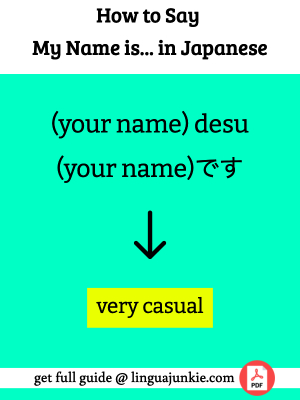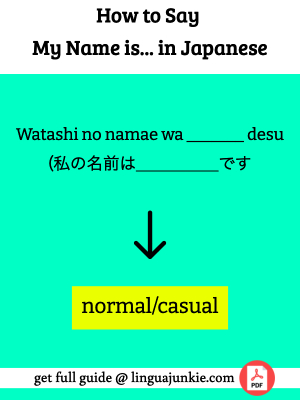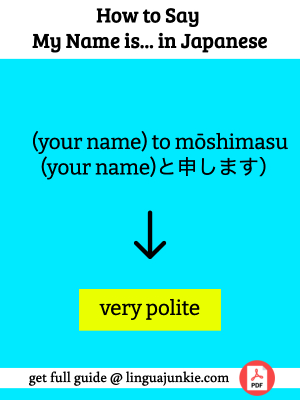Learning how to introduce yourself in Japanese is a first step to experiencing Japanese culture in an authentic way.
So, in this guide, you’ll learn to do that.
How to say my name is in Japanese.
Though there are many ways to say “my name is” in Japanese, you’ll learn easy 3 ways to say your name: casual, normal, and polite.
Let’s jump in.
 | Want a bundle of 30+ Japanese PDF Cheat sheets? These colorful and printable PDFs teach you Japanese words and phrases… and they’re free for new learners. Click here to get Japanese PDF Lessons |
3 Ways to Say My Name Is…
1. _______ desu
_______(です)
- Casual
Stating your name and adding “desu” is enough to introduce yourself.
When you meet someone for the first time, they will probably ask you what your name is. “ Onamae wa?” (お名前は?)
In this case, you can just answer this question by saying “____(your name)___ desu (です)” Namae (名前)means name, and we Japanese put “O”(お)in front to be polite referring to someone’s name. The “O” can also be placed in front of other nouns. ”desu” means “to be” and comes at the end of a sentence, as all Japanese sentences follow a subject-object-verb pattern.

2. Watashi no namae wa _______ desu
(私の名前は_____です)
- Normal
This next phrase iterally means “ My name is _______. ”Watashi” means “I” or “My”. “Namae” means “name” as mentioned before.
But please be careful that you do not say “Onamae” when you are referring your own name as it sounds like you are showing respect for yourself.

3. ________ to mōshimasu
______と申します)
- Polite
This phrase is an honorific way to present your name. “Mōshimasu” (申します)is a humble form of “iimasu”(言います)and it means “ to say”.
By using the humble form, you can show respect to the other person and the conversation will go smoothly. This formal language is usually used in a business setting or with people you haven’t established a close relationship with yet. Some may feel it is too formal to use honorifics, but this phrase is not too formal and it does not give an impression of exaggeration.

Hear How it Sounds
Now, it’s one thing to read about Japanese phrases…
It’s another thing to actually HEAR native speakers introduce themselves.
By listening, you can follow along and repeat and introduce yourself fluently.
So listen and hear real Japanese. Press play below. Try this Free Lesson from JapanesePod101.com (click here to visit) for the complete explanation about introducing yourself!
- Japanese in 3 Minutes
- Self Introductions
Now that you know how to say my name is in Japanese…
Let’s talk about how names work in Japanese.
How Names Work in Japanese
In Japan, the order of stating names is different from English.
Our name order is (Surname) + (Given name).
Obviously in English, the given name comes first, and then the surname/ family name. Though calling someone by their given name is quite normal in English, in Japan it may sound too intimate, or even rude. Therefore, it might be a good idea to avoid calling someone by their given name if you’re meeting them for the first time. Whether you call someone by their given name or surname, it is nice to add “san” (さん)after their name.
This is one of the several Japanese honorifics you should know.
“san” (さん)
“San” can be added after both male and female names, and works like Mr./ Ms/ Miss/ Mrs.
“San” can also be attached to the names of occupations and titles.
For example, SAKANAYA (魚屋)means fishmonger/fish dealer and we call them “Sakanaya-san” (魚屋さん). Shichō means “Mayor” and we can call him/her Shichō-san (市長さん). Bengoshi means lawyer, therefore “Bengoshi-san” (弁護士さん) can be used as well, and so on.
“Kun” (君)
More casual and less polite than “~san”, we use “kun”(君) to address a person who is younger than you – specifically, a younger boy.
A male might address a female by “kun,” usually in schools or companies.
But it isn’t used between women or when addressing someone superior to you.
“Chan” (ちゃん)
Similarly, “chan” (ちゃん)can be attached to children’s names when you call them by their given names.
“Chan” is used for girls, young children, babies, close friends, and grandparents, and even for cute animals.
It is used to show affection or closeness, therefore not appropriate to address someone whom you just met for the first time.
Now that you know about Japanese names…
How about foreign names?
Foreign names in Japanese
While Japanese names are written in Kanji or Kanji and Hiragana, foreign names are written in Katakana.
By the way, you can learn Katakana in 1 hour here, or about the Japanese alphabet overall.
You can spell them out in katakana to make them phonetically match with Japanese.
Using a Katakana chart, you can find a Katakana letter that corresponds to the pronunciation of your name.
Basic katakana chart:
| ア a | カ ka | サ sa | タ ta | ナ na | ハ ha | マ ma | ヤ ya | ラ ra | ワ wa |
| イ i | キ ki | シ shi | チ chi | ニ ni | ヒ hi | ミ mi | リ ri | ||
| ウ u | ク ku | ス su | ツ tsu | ヌ nu | フ fu | ム mu | ユ yu | ル ru | ヲ o |
| エ e | ケ ke | セ se | テ te | ネ ne | ヘ he | メ me | レ re | ||
| オ o | コ ko | ソ so | ト to | ノ no | ホ ho | モ mo | ヨ yo | ロ ro | ン n |
For example, if your name is “Anna”, look for the Katakana character for A, which is ア, then the character for N, which is ン, and then the character for “NA”, which is ナ. You just need to put them together and you can write your name “アンナ”.
If your name is a bit more complicated or doesn’t sound how it’s written, you will need to 1) understand Japanese sounds/pronunciation, and then 2) work from the sounds.
You can learn how to translate your name into Japanese by clicking the link.
Conclusion
Now you know a little bit about how Japanese names work…
How to say my name is in Japanese… and introduce yourself…
So, leave me a comment and tell me your name!
– The Main Lingua Junkie
P.S. Interested in learning Japanese? This Japanese course for Absolute Beginners from JapanesePod101 is FREE for a limited time only. They plan to close it down in the future, but while it’s still open, give it a try. Click the image below.
